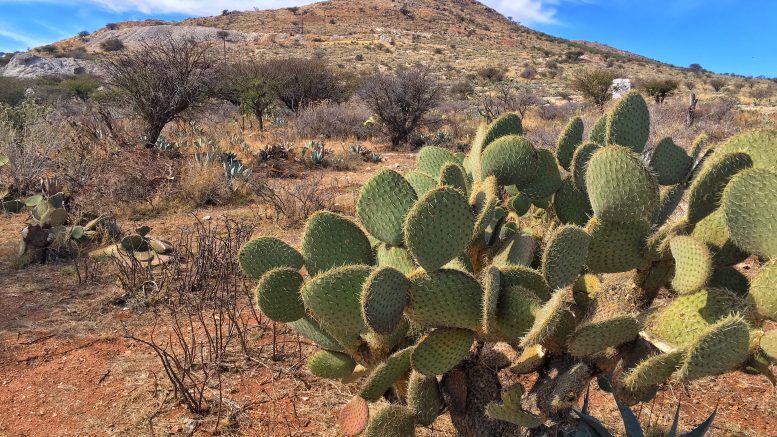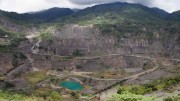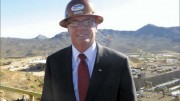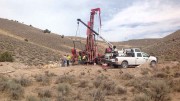GUADALUPE VICTORIA, DURANGO STATE, MEXICO — Southern Silver Exploration (TSXV: SSV) hopes that its polymetallic Cerro las Minitas project — “a hill of many small mines” in English — could become known here in north-central Mexico as “a hill with one big mine,” once the company completes its current 10,000-metre drill program.
The Vancouver-based junior explorer aims to expand the project’s current resource of 36.5 million indicated equivalent oz. silver and 77.3 million inferred equivalent oz. silver by drilling the Blind Shoulder zone, a newfound zinc-rich skarn target buried at depth.
The latest drilling into Blind Shoulder has returned 15.1 metres of 39.4 grams silver per tonne, 0.1% lead and 10.2% zinc in hole 16LCM-91 — a 150-metre stepout from hole 13CLM-66, which returned 9.3 metres of 9.4 grams silver, 0.1% copper and 13% zinc.
The intercept is also 250 metres away from the 2016 discovery hole, 16CLM-88, which returned 30.4 metres of 107 grams silver, 0.4% copper, 1.1% lead and 2.3% zinc.
The Northern Miner travelled to Durango state to meet with Southern Silver’s general manager of exploration Robert Macdonald, and president Lawrence Page — the legendary lawyer who backed the discovery and development of the world-class Snip, Eskay and Hemlo gold mines in B.C. and Ontario — to take a look at fresh drill core and see how the project is advancing.

Southern Silver Exploration’s general manager of exploration Robert Macdonald (left) gets the latest drill report from project geologist Juan Lopez Luque at the company’s core shack at the Cerro las Minitas silver project in Mexico. Photo by Lesley Stokes.
“We already have a great deposit as it is, but once we hit the Blind Shoulder zone we just followed the high grade, and we think we can double what we have right now,” Macdonald says during our drive to the property.
As the truck weaves its way past the city of Guadalupe Victoria, Cerro las Minitas appears on the horizon as a prominent hill rising out of the bean fields. The weather is a chilly 3ºC and wind blows dozens of plastic bags from a nearby landfill across the freshly tilled farmlands.

At the Cerro Las Minitas property in Durango state, Mexico, from left: Newsletter writer Eric Muschinski; Southern Silver Exploration project geologist Juan Lopez Luque; Southern Silver president Lawrence Page; and Southern Silver general manager of exploration Robert MacDonald. Photo by Lesley Stokes.
Surrounding the crest of the hill — which is actually a granitic plug poking out at surface — are green rocks caked in sulphides, and a number of small, historic metal head frames made by artisanal miners.
Macdonald says that the carbonate rocks acted as a sponge to the metal-rich fluids that off-gassed from the granitic intrusive, and were baked into a green colour by the heat — a type of mineralizing system geologists call a “skarn.”
Skarns, and similar carbonate-replacement deposits, are the second-largest contributor to Mexico’s historic silver production, after epithermal veins.
While the hill has been an epicentre for exploration and small-scale mining, most of Southern Silver’s focus is on the surrounding gravel flatlands, where the company has identified two main mineralization zones: Blind and El Sol.

Cartoon schematic displaying the deposit types and blue sky potential at Southern Silver’s Cerro Las Minitas polymetallic project in Durango state, Mexico. Credit: Southern Silver Exploration.
Southern Silver found Blind and El Sol in 2011, while drilling induced-polarization geophysical anomalies beyond the main intrusion. The mineralization occurs along the margins of sub-vertical dikes, and has been drilled at least 1 km along strike and up to 600 metres deep.
In March 2016, the company reported that Blind and El Sol contain 3.7 million indicated tonnes of 305 equivalent grams silver (90 grams silver, 0.05 gram gold per tonne, 2.3% lead, 2.5% zinc and 0.1% copper), whereas inferred resources add 6.6 million tonnes of 363 equivalent grams silver (82 gram silver, 0.17 gram gold, 1.6% lead and 4.3% zinc, and 0.2% copper). Inferred resources include the Santo Nino mineralization zone along the western margin of the central intrusion.

Plan map showing location of planned 2017 drill holes against previous drilling at Southern Silver Exploration’s Cerro Las Minitas polymetallic project, Durango state, Mexico. Credit: Southern Silver Exploration.
Macdonald says the company was following the mineralization at the Blind zone down-dip when it found the Blind Shoulder target last year.
“We drilled a hole that hit high-grade mineralization at 650 metres deep and then bottomed in a monzonite intrusive, and that gave us the idea that the central intrusion itself may be flattening — either as a large sill, or as the shoulders of a larger intrusion at depth.”
And drilling supports the theory, he adds.
Southern Silver is targeting Blind Shoulder with drill holes across a 600- by 400-metre area.
Over 1 km east of Blind-El Sol, another drill rig is testing mineralized zones outboard of the Mina la Bocona, a skarn deposit formerly mined by artisanal workers to 220 metres deep. Drill results last year returned 9.3 metres of 275 grams silver, 0.9 gram gold, 4.3% lead and 1.9% zinc.
The company expects to finish its program in May, and update the resource estimate by July.
“Once we get the resource update complete we’ll look at whether it makes sense to proceed with a preliminary economic study,” Macdonald says. “If we double what we have, we could be looking at a 15- to 20-year mine life.”

Southern Silver Exploration project geologist Juan Lopez Luque (centre, gesturing) leads the geology conversation at the company’s Cerro Las Minitas polymetallic project in Durango state, Mexico. Photo by Lesley Stokes.
Electrum Group
During the one-hour journey back to Durango City, the conversation steers away from the recent drill results and towards the privately owned Wall Street investment firm Electrum Group, which is Southern Silver’s 38% shareholder, and 60% partner at Cerro las Minitas.
Page chimes in that Electrum fast-tracked the remaining US$2 million to earn 60% indirect interest in the property, bringing Electrum’s total expenses up to $5 million.
The group, which was founded by billionaire Thomas Kaplan, got involved in the project in May 2015, after its chief consulting geologist, Larry Buchanan, recommended it take a closer look at Southern Silver’s 130 sq. km land package.

Top: High-grade zinc drill core from Southern Silver Exploraion’s shallowly dipping Blind Shoulder zone, a skarn target at roughly 600 metres depth. Bottom: High-grade silver drill core from the steeply-dipping Blind skarn deposit. Photos by Lesley Stokes.
Buchanan is a seasoned geologist and a past recipient of the Prospectors & Developers Association of Canada’s Thayer Lindsley Award for his part in finding the 450 million oz. silver San Cristobal epithermal deposit in Bolivia.
Page says Buchanan saw similarities between Cerro las Minitas and Electrum’s Los Gatos polymetallic project in northern Mexico.
Electrum’s privately held Sunshine Silver Mining & Refining and 30% partner Dowa Metals & Mining recently completed a feasibility study and built a decline at Los Gatos. The deposit hosts 9.2 million measured and indicated tonnes of 289 grams silver, 5.7% zinc, 2.8% lead and 0.36 gram gold. Inferred resources add 3.6 million tonnes of 124 grams silver, 4.6% zinc, 3% lead and 0.27 gram gold.
“They’re a great group, and Kaplan is a kind of renaissance man who likes to spend money on exploration,” Page says. “They’ve done a great job providing us with the capital to advance the project forward, but have also been helpful on the technical side. They see a lot of value in Los Gatos, and because of its geological similarities, they see a lot of potential at Cerro las Minitas.”

Southern Silver Exploration personnel meet with Durango state officials, from left: Mauricio Heiras Garibay, legal counsel for Southern Silver; Lawrence Page, president of Southern Silver; Jose Aispuro Torres, Durango state’s governor; Robert Macdonald, general manager of exploration at Southern Silver; Ramon Davila Flores, Durango state’s minister of economic development; Abel Cano Mendoza, VHG Legal Services; Juan Lopez Luque, project geologist at Southern Silver. Credit: Southern Silver Exploration.
It may not be surprising that Cerro las Minitas has drawn the attention of seasoned investors and explorers. The deposit is located in a prestigious mining district, with Hecla Mining’s (NYSE: HL) San Sebastian gold-silver mine, 10 km east; Coeur Mining’s (NYSE: CDE) La Preciosa silver-gold mine, 28 km west; and Avino Silver and Gold Mines’ (TSXV: ASM; NYSE-MKT: ASM) Avino silver-gold-copper mine, 14 km west.
The nearby deposits are classed as epithermal vein systems, which typically form at some distance to an underlying porphyry intrusive. Macdonald says the rocks surrounding Cerro las Minitas may have been uplifted, exposing the deeper roots of an intrusion that stained the country rocks with metals.
The potential for a porphyry sitting closer to surface is what drew mining giant Freeport-McMoRan (NYSE: FCX) to Cerro las Minitas in 2012. The company spent US$5 million searching for a buried porphyry deposit, but walked away in 2014 when it couldn’t find one.
“They drilled a couple of deep holes and did airborne electromagnetic surveys and ground surveys, but decided the project wasn’t for them,” Macdonald says. “In one of their drill holes they hit the Blind zone at 600 metres deep, which was 300 metres deeper than where we were drilling at the time. So that allowed us to spread our arms and say with confidence that these skarns extend to considerable depth.”
During a quick stop at the company’s core shack in Guadalupe Victoria, Macdonald lays out several cross sections beside the drill core and discusses some of the company’s drilling priorities.
He notes the Blind and El Sol zones could end in the southeast, whereas geophysical data indicates the Blind Shoulder target continues at depth.
“It could be a structure that cuts off the Blind zone in the southeast, or it could just be the natural irregularities of how the intrusive was emplaced,” Macdonald says. “Right now we’re interested in the high grades we see at depth, and we’re encouraged with the results so far.”
Macdonald and Page mention they plan to meet Ramon Davila Flores — Durango state’s newly appointed minister of economic development and former director of First Majestic Silver (TSX: FR; NYSE: AG) — the next day in Durango city’s business district. Davila would be joined by the Durango state governor, Jose Aispuro Torres.
In a follow-up phone interview with Page a few days later, he says the meeting was “excellent,” and that “they were just as keen to meet us as we were to meet them. Davila used to own claims on our property so he’s familiar with the project, and they asked if there was anything the government could do to help us.
“They’re going to be at PDAC and want to have more meetings with Canadian companies. The new minister supports the mining industry and wants to bring a lot of investment capital into the economy.”
Shares of Southern Silver have traded in a 52-range of 4¢ to 66¢, and traded at 46¢ per share at press time. The company has 84.1 million shares outstanding for a $39-million market capitalization.






EXCELLENT article – great company indeed!!!
Good points all around. Truly aptedciapre.